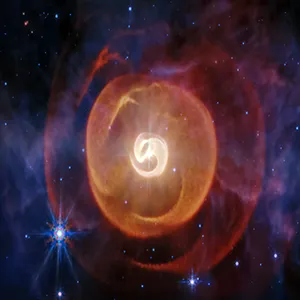
Webb captures a cosmic serpent of dust hiding in plain sight
NASA’s James Webb Space Telescope (JWST) has captured the sharpest mid-infrared view yet of the powerful star system, Apep. This rare, chaotic triple-star system features two central Wolf–Rayet stars that shed dust in perfectly spaced, snaking shells.
Earlier ground-based searches had glimpsed only a single ring and suspected there might be more.
Webb’s MIRI instrument now lays out four nested spirals – one almost ghostlike at the image’s edge – ejected in successive episodes over the last 700 years.
“Looking at Webb’s new observations was like walking into a dark room and switching on the light – everything came into view,” said lead author Yinuo Han from Caltech.
“There is dust everywhere in Webb’s image, and the telescope shows that most of it was cast off in repetitive, predictable structures.”
Apep star systems dust clock
By combining Webb’s measurements of ring positions with eight years of expansion-speed tracking from the European Southern Observatory’s Very Large Telescope (VLT), Han and co-author Ryan White from Macquarie University pinned down Apep star system’s orbital timing.
The two Wolf–Rayet stars in the tight inner pair complete an elongated loop roughly every 190 years.
During the close pass phase that lasts about 25 years each orbit, their ferocious stellar winds crash together, mix, and condense heaps of carbon-rich dust that shoots outward to form each new shell.
“This is a one-of-a-kind system with an incredibly rare orbital period,” White said. “The next longest orbit for a dusty Wolf-Rayet binary is about 30 years. Most have orbits between two and 10 years.”
In many other colliding-wind binaries, the dusting episodes are brief, sometimes just months, as in Wolf–Rayet 140. Apep’s longer dust-making “season” explains the broad, continuous spirals MIRI can now resolve.
Triple star bound to the Apep system
Webb’s image also confirms that Apep is not just a binary. A massive supergiant star orbits farther out, gravitationally bound to the pair and acting like a blade slicing through each expanding dust sheet.
The evidence is geometric: a repeating funnel-shaped cavity that lines up from shell to shell.
“To find the holes the third star has cut like a knife through the dust, look for the central point of light and trace a V-shape from about 10 o’clock to 2 o’clock,” said White. “The cavity is more or less in the same place in each shell and looks like a funnel.”
“I was shocked when I saw the updated calculations play out in our simulations. Webb gave us the ‘smoking gun’ to prove the third star is gravitationally bound to this system.”
MIRI sees what others missed
Wolf–Rayet winds are among the fastest known, and Apep’s are no exception. Its dust is hurled outward at roughly 1,200–2,000 miles per second (2,000–3,000 kilometers per second).
Despite the speed and harsh radiation, the grains are unusually stubborn radiators. The dust is largely amorphous carbon, which stays warm longer as it coasts away.
That warmth emits faint mid-infrared light – exactly the domain where Webb’s MIRI excels.
Ground telescopes struggled to pick up the outer, cooler shells against the glow of Earth’s own atmosphere. MIRI’s optics and exquisite sensitivity brought them into view.
Rewinding Apep’s past cycles
Linking shell spacing, expansion speed, and orbital dynamics lets astronomers rewind Apep’s mass-loss history.
Each spiral loop is a timestamp: a 25-year dust-making arc forged near periastron, then stretched outward by the stars’ motion and the grains’ own ballistic flight.
Over seven centuries, the system has emitted a series of near-clockwork waves, even as the third star’s “knife” repeatedly carves out the same cavity.
What comes next will likely be a violent event. Wolf–Rayet stars form when massive, evolved titans shed their outer layers after starting life far heftier than the Sun.

Solving mysteries with Webb
In Apep, the inner pair has already jettisoned most of its mass and likely each now weighs between about 10 and 20 solar masses.
The outer supergiant could be two to five times heavier still. Both Wolf–Rayet stars will end as core-collapse supernovae and seed their surroundings with freshly minted elements.
Either could also unleash a gamma-ray burst, the most luminous kind of cosmic explosion, before collapsing into a black hole.
“We solved several mysteries with Webb,” Han said. “The remaining mystery is the precise distance to the stars from Earth, which will require future observations.”
A rare stellar laboratory
Wolf–Rayet stars are rare, perhaps only a thousand in the Milky Way, and dusty colliding-wind pairs are rarer still.
Among the few hundred known Wolf–Rayet binaries, Apep is unique in our galaxy for hosting two Wolf–Rayet stars of these types in one bound system.
That rarity turns Apep into an astrophysical laboratory. Its spirals archive how extreme stellar winds build carbon dust, how triple-star gravity sculpts outflows, and how massive stars shed mass in the centuries before they explode.
Lessons from the Apep star system
Webb’s image also offers a striking methodological lesson. By coupling MIRI’s high-contrast mid-IR view to long-baseline kinematic monitoring from the VLT, the team could convert a static picture into a dynamic clock.
This mechanism can recover orbits, ejection rates, and geometry in a way that neither facility alone could achieve.
As White noted, the 190-year period stands out like a sore thumb in the broader Wolf–Rayet population. It invites theorists to test how such a leisurely, highly productive dust engine forms and persists.
Apep’s “serpents” continue to unwind – their coils preserving each long encounter and showing the same distant blade slicing through every ring as they race outward. And thanks to Webb, the full choreography is finally visible.
—–
Like what you read? Subscribe to our newsletter for engaging articles, exclusive content, and the latest updates.
Check us out on EarthSnap, a free app brought to you by Eric Ralls and Earth.com.
—–













